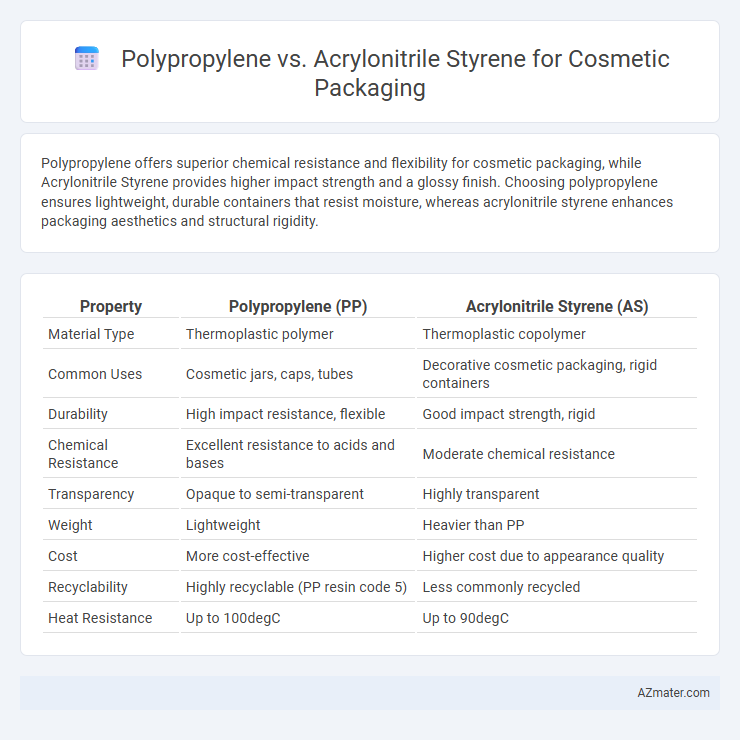Polypropylene offers superior chemical resistance and flexibility for cosmetic packaging, while Acrylonitrile Styrene provides higher impact strength and a glossy finish. Choosing polypropylene ensures lightweight, durable containers that resist moisture, whereas acrylonitrile styrene enhances packaging aesthetics and structural rigidity.
Table of Comparison
| Property | Polypropylene (PP) | Acrylonitrile Styrene (AS) |
|---|---|---|
| Material Type | Thermoplastic polymer | Thermoplastic copolymer |
| Common Uses | Cosmetic jars, caps, tubes | Decorative cosmetic packaging, rigid containers |
| Durability | High impact resistance, flexible | Good impact strength, rigid |
| Chemical Resistance | Excellent resistance to acids and bases | Moderate chemical resistance |
| Transparency | Opaque to semi-transparent | Highly transparent |
| Weight | Lightweight | Heavier than PP |
| Cost | More cost-effective | Higher cost due to appearance quality |
| Recyclability | Highly recyclable (PP resin code 5) | Less commonly recycled |
| Heat Resistance | Up to 100degC | Up to 90degC |
Introduction to Cosmetic Packaging Materials
Polypropylene (PP) and Acrylonitrile Styrene (AS) are widely used materials in cosmetic packaging due to their durability and aesthetic appeal. PP offers excellent chemical resistance, lightweight properties, and flexibility, making it suitable for containers and caps in cosmetic products. AS provides superior hardness, clarity, and impact resistance, ideal for transparent packaging such as jars and compacts.
Overview of Polypropylene (PP)
Polypropylene (PP) is a versatile thermoplastic polymer widely used in cosmetic packaging due to its excellent chemical resistance, lightweight nature, and high durability. Its moisture barrier properties and resistance to heat make it ideal for packaging creams, lotions, and other cosmetic products that require protection from contamination and spoilage. Polypropylene also offers cost-effectiveness and recyclability, aligning with sustainable packaging trends in the beauty industry.
Overview of Acrylonitrile Styrene (AS)
Acrylonitrile Styrene (AS) is a thermoplastic known for its excellent clarity, impact resistance, and chemical stability, making it a preferred choice for cosmetic packaging that demands durability and aesthetic appeal. This polymer exhibits superior resistance to oils, fats, and various chemicals commonly found in cosmetic products, ensuring product integrity and shelf life. Its ability to be easily molded into complex shapes and its glossy finish enhance the visual appeal of cosmetic containers, setting it apart from polypropylene in premium packaging applications.
Chemical Structure Comparison
Polypropylene (PP) features a simple hydrocarbon polymer chain primarily composed of repeating propylene units, providing high chemical resistance and low moisture absorption ideal for cosmetic packaging. Acrylonitrile Styrene (AS) consists of a copolymer with rigid styrene segments and acrylonitrile units, which confer enhanced strength, clarity, and resistance to solvents but higher brittleness compared to PP. The chemical structure differences affect barrier properties, with PP offering superior chemical inertness and AS delivering better surface hardness and aesthetic appeal for cosmetics containers.
Barrier Properties: Moisture and Oxygen Resistance
Polypropylene (PP) offers excellent moisture resistance, making it ideal for cosmetic packaging that requires protection against humidity, while its oxygen barrier properties are moderate and can be enhanced with coatings. Acrylonitrile Styrene (AS) exhibits superior oxygen barrier properties compared to PP, effectively preserving product integrity by limiting oxidation but provides less moisture resistance. Selecting between these materials depends on the cosmetic formulation's sensitivity to oxygen and moisture, balancing barrier performance with packaging durability and clarity.
Aesthetic Qualities and Finish
Polypropylene (PP) offers a smooth, glossy finish that enhances the vibrant colors and clarity of cosmetic packaging, making it ideal for products emphasizing visual appeal. Acrylonitrile Styrene (ABS) provides a sturdy, high-gloss surface with excellent resistance to scratches and impact, ensuring long-lasting aesthetic quality in premium cosmetic containers. Both materials support diverse finishing techniques like printing, embossing, and laminating, allowing for customizable designs that elevate brand presentation.
Durability and Impact Resistance
Polypropylene offers excellent durability and chemical resistance, making it ideal for cosmetic packaging that requires long-term stability and protection against various formulations. Acrylonitrile Styrene (AS) provides superior impact resistance and rigidity, ensuring containers withstand drops and rough handling without cracking. Choosing between polypropylene and AS depends on the specific packaging needs, balancing flexibility and toughness for optimal product safety.
Compatibility with Cosmetic Formulations
Polypropylene (PP) exhibits excellent chemical resistance and low moisture absorption, making it highly compatible with a wide range of cosmetic formulations, especially oil-based and water-based products. Acrylonitrile Styrene (AS) offers good clarity and aesthetic appeal but has moderate resistance to aggressive solvents and long-term exposure, limiting its use with certain cosmetic ingredients such as alcohols or essential oils. Selecting PP ensures durability and stability for formulations containing preservatives and oils, while AS suits products requiring enhanced visual presentation but less chemical resistance.
Sustainability and Environmental Impact
Polypropylene (PP) offers superior sustainability for cosmetic packaging due to its high recyclability and lower carbon footprint compared to Acrylonitrile Styrene (AS), which is more energy-intensive to produce and less easily recycled. PP's resistance to chemical leaching and its compatibility with circular economy initiatives make it an environmentally preferable choice in the beauty industry. In contrast, AS packaging often contributes more to landfill waste and environmental pollution due to its limited recycling infrastructure and greater reliance on fossil-fuel-based raw materials.
Cost Analysis and Market Availability
Polypropylene offers a cost-effective solution for cosmetic packaging due to its low raw material and production expenses, making it ideal for high-volume applications. Acrylonitrile Styrene, while more expensive, provides superior chemical resistance and aesthetic appeal, appealing to premium cosmetic brands. Both materials are widely available globally, but polypropylene benefits from greater market availability and established supply chains, ensuring consistent pricing and accessibility.

Infographic: Polypropylene vs Acrylonitrile Styrene for Cosmetic Packaging
 azmater.com
azmater.com